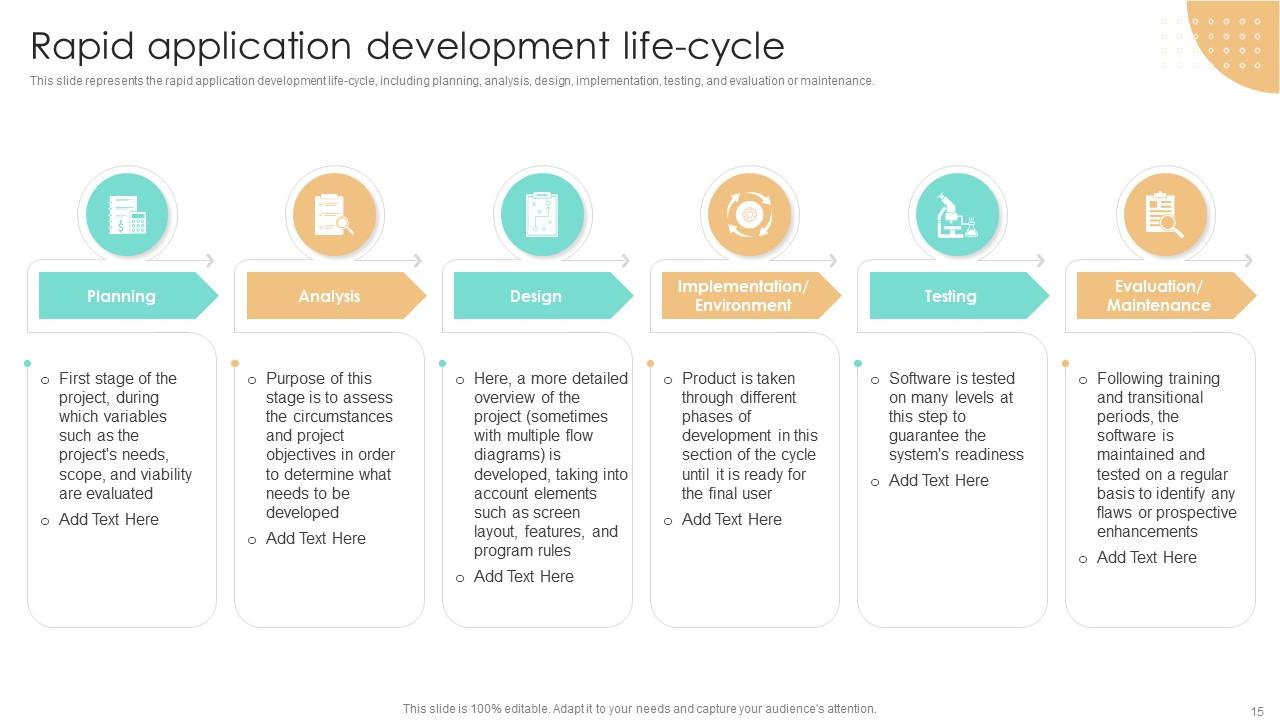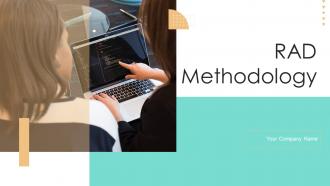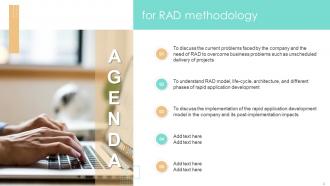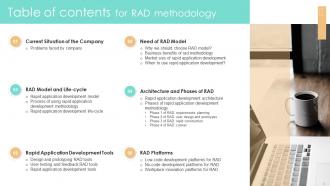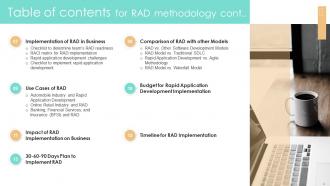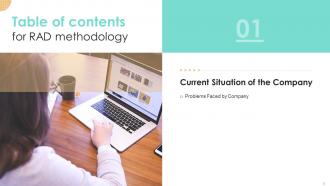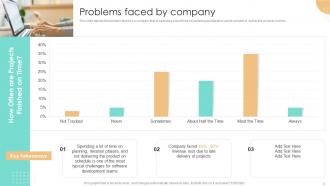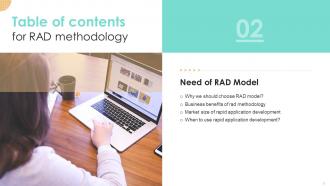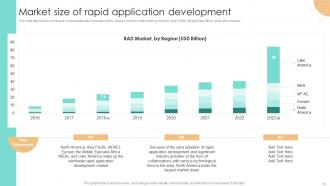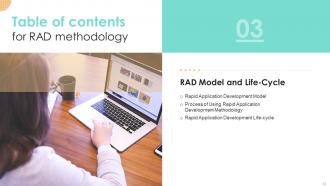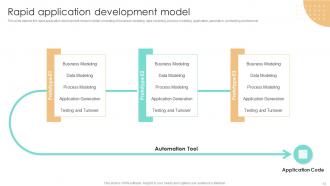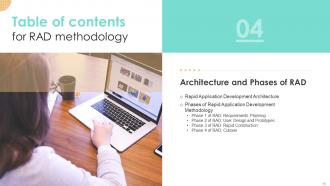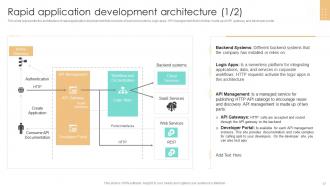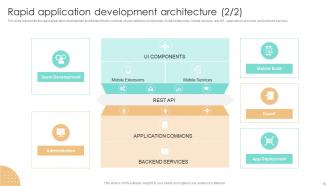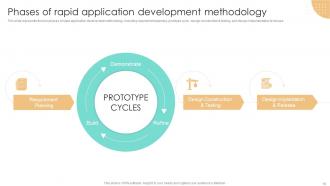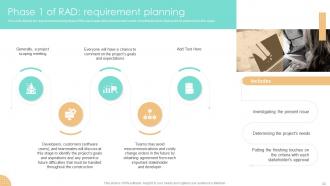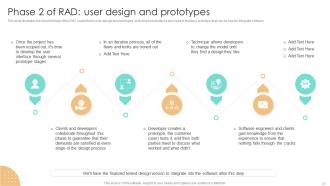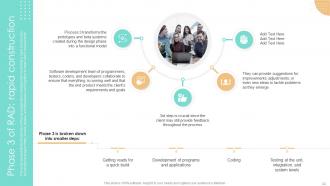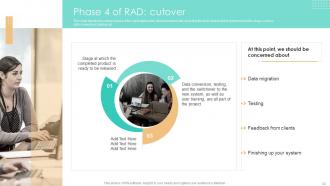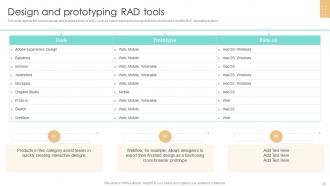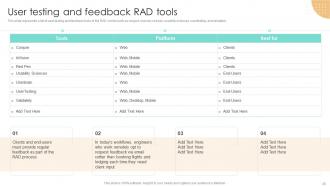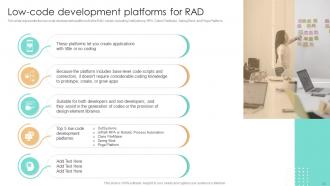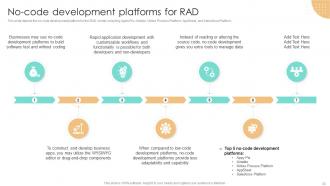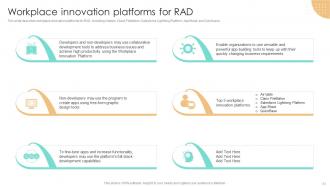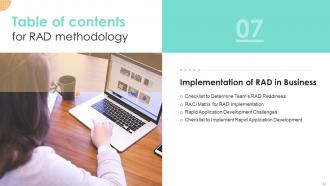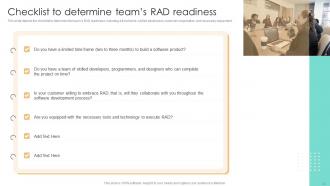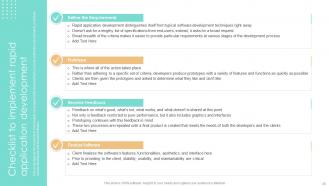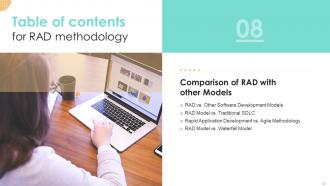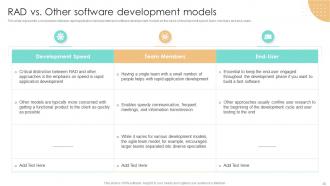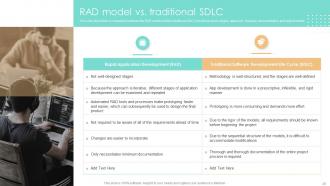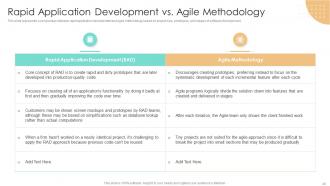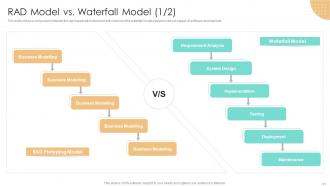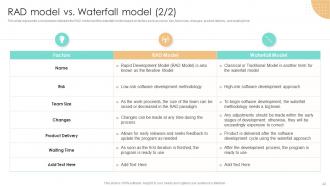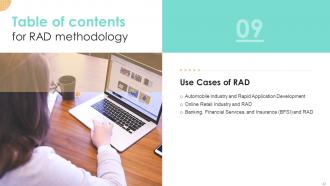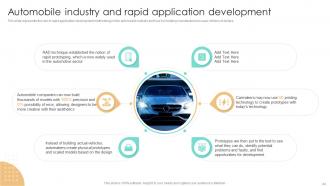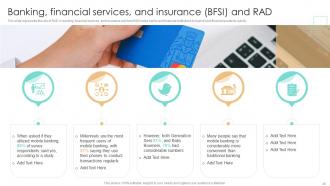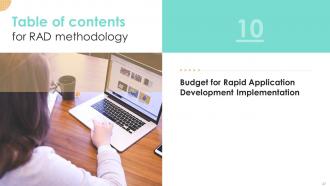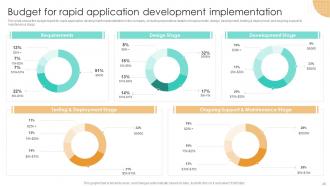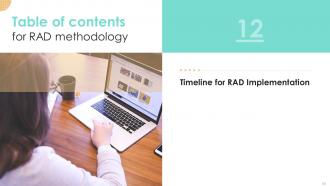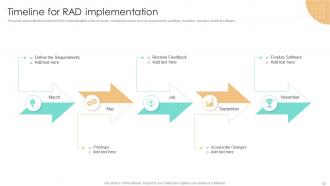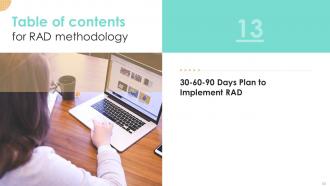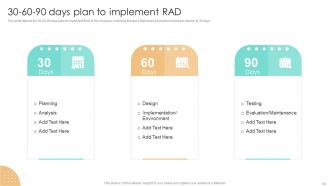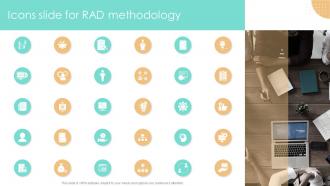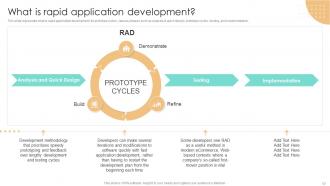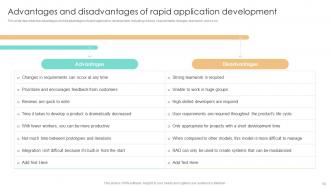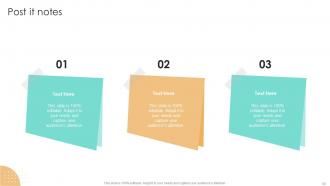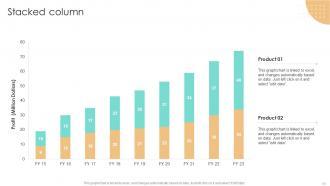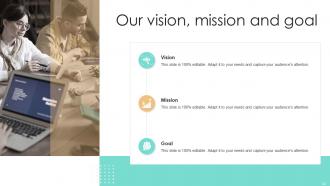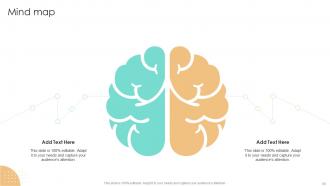RAD Methodology Powerpoint Presentation Slides
RAD Methodology is an adaptive software development technique in which a software model is immediately modified based on user feedback. Check out our professionally designed RAD Methodology template that gives a brief idea about current problems faced by the company. In this PowerPoint Presentation, we have covered the need for RAD by showcasing details of its business benefits and market size. Along with this, it also talks about the right time for implementing RAD in the company. In addition, this RAD Methodology PPT contains the RAD model, usage process, life-cycle, and the architecture of RAD methodology. Also, the presentation includes standard phases of the RAD model such as requirement planning, user design and prototypes, rapid construction, and cutover. Moreover, it contains different RAD tools, platforms, and how to implement RAD in the company. Furthermore, this template compares the RAD model with other models such as Agile, Waterfall, and traditional SDLC. In addition to this, it also caters to use-cases of RAD and a budget to implement RAD in the organization. Lastly, this RAD Methodology deck comprises impacts of RAD implementation on business, a timeline, etc. Download it now.
You must be logged in to download this presentation.
 Impress your
Impress your audience
Editable
of Time
PowerPoint presentation slides
Enthrall your audience with this RAD Methodology Powerpoint Presentation Slides. Increase your presentation threshold by deploying this well-crafted template. It acts as a great communication tool due to its well-researched content. It also contains stylized icons, graphics, visuals etc, which make it an immediate attention-grabber. Comprising sixty six slides, this complete deck is all you need to get noticed. All the slides and their content can be altered to suit your unique business setting. Not only that, other components and graphics can also be modified to add personal touches to this prefabricated set.
People who downloaded this PowerPoint presentation also viewed the following :
Content of this Powerpoint Presentation
Slide 1: This slide introduces RAD Methodology. State your company name and begin.
Slide 2: This slide states Agenda of the presentation.
Slide 3: This slide shows Table of Content for the presentation.
Slide 4: This is another slide continuing Table of Content for the presentation.
Slide 5: This slide shows title for topics that are to be covered next in the template.
Slide 6: This slide depicts the problem faced by a company that is spending a lot of time on planning.
Slide 7: This slide shows title for topics that are to be covered next in the template.
Slide 8: This slide represents the reasons that why we should choose the rapid application development model.
Slide 9: This slide shows the business benefits of the rapid application development methodology.
Slide 10: This slide presents Market Size of Rapid Application Development.
Slide 11: This slide defines when an organization can use rapid application development based on prototype testing.
Slide 12: This slide shows title for topics that are to be covered next in the template.
Slide 13: This slide depicts the rapid application development model in detail consisting of business modeling.
Slide 14: This slide presents Process of Using Rapid Application Development Methodology.
Slide 15: This slide represents the rapid application development life-cycle, including planning, analysis, design, etc.
Slide 16: This slide shows title for topics that are to be covered next in the template.
Slide 17: This slide displays architecture of rapid application development that consists of backend systems.
Slide 18: This slide represents rapid application development architecture that is consists of user interface components.
Slide 19: This slide showcases Phases of Rapid Application Development Methodology.
Slide 20: This slide depicts the requirement planning phase of the rapid application development model.
Slide 21: This slide illustrates the second phase of the RAD model that is user-design and prototypes.
Slide 22: This slide presents third phase of the rapid application development model that is rapid construction.
Slide 23: This slide depicts the cutover phase of the rapid application development model.
Slide 24: This slide shows title for topics that are to be covered next in the template.
Slide 25: This slide depicts the various design and prototype tools of RAD, such as adobe experience design.
Slide 26: This slide represents a list of user testing and feedback tools of the RAD model such as conjure.
Slide 27: This slide depicts the rapid application development tools such as alpha software.
Slide 28: This slide shows title for topics that are to be covered next in the template.
Slide 29: This slide presents low-code development platforms for the RAD model.
Slide 30: This slide depicts the no-code development platform for the RAD model, including Apple Pie.
Slide 31: This slide displays Workplace Innovation Platforms for RAD.
Slide 32: This slide shows title for topics that are to be covered next in the template.
Slide 33: This slide presents Checklist to Determine Team’s RAD Readiness.
Slide 34: This slide describes the RACI matrix for rapid application development implementation in the organization.
Slide 35: This slide displays rapid application development challenges, including being heavily reliant on the client.
Slide 36: This slide showcases Checklist to Implement Rapid Application Development.
Slide 37: This slide shows title for topics that are to be covered next in the template.
Slide 38: This slide represents a comparison between rapid application development and software development models.
Slide 39: This slide describes a comparison between the RAD model and the traditional SDLC model based.
Slide 40: This slide showcases Rapid Application Development vs. Agile Methodology.
Slide 41: This slide shows a comparison between the rapid application development model and the waterfall model.
Slide 42: This slide represents a comparison between the RAD model and the waterfall model.
Slide 43: This slide shows title for topics that are to be covered next in the template.
Slide 44: This slide presents Automobile Industry and Rapid Application Development.
Slide 45: This slide depicts the application of rapid application development in the online retail industry.
Slide 46: This slide represents the role of RAD in banking, financial services, and insurance.
Slide 47: This slide shows title for topics that are to be covered next in the template.
Slide 48: This slide showcases Budget for Rapid Application Development Implementation.
Slide 49: This slide shows title for topics that are to be covered next in the template.
Slide 50: This slide presents Impacts of RAD Implementation on Business.
Slide 51: This slide shows title for topics that are to be covered next in the template.
Slide 52: This slide displays timeline for RAD implementation in the company.
Slide 53: This slide shows title for topics that are to be covered next in the template.
Slide 54: This slide depicts the 30-60-90 days plan to implement RAD in the company.
Slide 55: This slide contains all the icons used in this presentation.
Slide 56: This slide is titled as Additional Slides for moving forward.
Slide 57: This slide represents what is rapid application development.
Slide 58: This slide showcases Advantages and disadvantages of rapid application development.
Slide 59: This is a Timeline slide. Show data related to time intervals here.
Slide 60: This slide shows Post It Notes. Post your important notes here.
Slide 61: This slide represents Stacked column chart with two products comparison.
Slide 62: This is Our Mission slide with related imagery and text.
Slide 63: This slide depicts Venn diagram with text boxes.
Slide 64: This slide presents Roadmap with additional textboxes.
Slide 65: This slide displays Mind Map with related imagery.
Slide 66: This is a Thank You slide with address, contact numbers and email address.
RAD Methodology Powerpoint Presentation Slides with all 71 slides:
Use our RAD Methodology Powerpoint Presentation Slides to effectively help you save your valuable time. They are readymade to fit into any presentation structure.
FAQs
Rapid Application Development (RAD) is a software development methodology that emphasizes iterative development and the use of prototypes to develop quickly and test software applications. RAD typically involves close collaboration between developers and end-users, as well as the use of tools and technologies designed to speed up the development process.
The Rapid Application Development (RAD) model typically consists of four phases: requirement planning, user design and prototypes, rapid construction, and cutover. In the requirement planning phase, the project requirements are identified and defined. In the user design and prototypes phase, prototypes of the software application are developed and tested. In the rapid construction phase, the application is built using the results of the prototype testing. Finally, in the cutover phase, the application is deployed to the end users.
Some benefits of using Rapid Application Development (RAD) include faster development and delivery times, improved collaboration between developers and end-users, greater flexibility and adaptability in response to changing requirements, and the ability to deliver working software prototypes early in the development cycle.
Some challenges of using Rapid Application Development (RAD) include being heavily reliant on the client's involvement and feedback, potential difficulties in scaling the process for larger projects, and the risk of overlooking important features or requirements due to the rapid pace of development.
Rapid Application Development (RAD) can be used in a variety of industries, including but not limited to the automobile industry, online retail, and banking, financial services, and insurance (BFSI). The methodology is well-suited to projects with fast turnaround times, such as those in the e-commerce and financial services sectors.
-
I was never satisfied with my own presentation design but SlideTeam has solved that problem for me. Thank you SlideTeam!
-
Very unique and reliable designs.
















